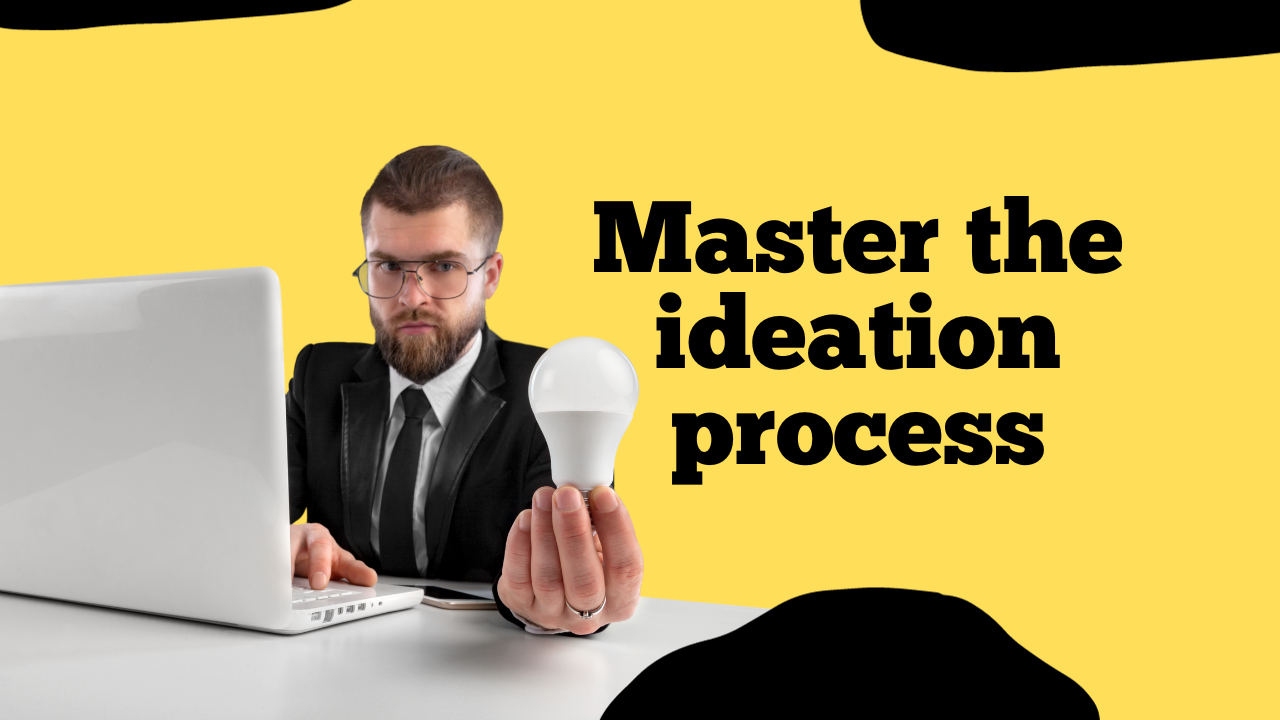
Great ideas come unexpectedly.
Sometimes, even when you spend the entire day pondering, inspiration and creative ideas may be elusive. In some cases, you might come up with dozens of ideas only to realize that none of them truly pique your interest.
Then there are those moments when your muse decides to drop a stroke of genius into your brain in the middle of the night while you’re in bed. And unless you capture it in writing right then and there, you risk forgetting it forever.
Having access to a constant flow of creative ideas is often essential in various fields, whether you’re an entrepreneur, a creator, a craftsman, or a marketer.
Creativity and the ideation process, even today, remain mysterious concepts. Nevertheless, it is entirely possible to gain more mastery over this process to learn how to reliably generate more creative ideas.
Where do good ideas come from?

Before delving into the ideation process, it’s essential to understand what an idea truly is.
According to Elizabeth Gilbert, the author of the book “Eat, Pray, Love,” there are two perspectives on how ideas are generated:
- Ideas are the product of pure mental effort: solely through the forces of willpower and concentration, it’s possible to discover ideas through a trial-and-error process. This approach can be frustrating as it relies entirely on an individual’s intellectual capabilities.
- Ideas spontaneously arise from mechanisms beyond our control: previously (and even today), we envisioned a muse – a creative capacity within us – that would activate unexpectedly to grant us access to good ideas. This is a more abstract, and somewhat impractical, viewpoint on the concept of ideation.
In reality, the most plausible explanation combines both perspectives: all the information gathered from our environment is processed by our brain, and ideas are essentially associations between this new data.
Although it’s often claimed that creative ideas exclusively come from the right hemisphere of the brain, this isn’t entirely accurate.
Creativity involves the activation of various parts of the brain at different stages of the process, with the prefrontal cortex playing a significant role in the spontaneous and deliberate formation of new associations between different concepts.
“Creativity is the process of making connections between different data points, with each data point referring to a lived experience, a discovered concept, or collected information.”
This theme recurs in numerous stories of inventions and discoveries.
The idea for Velcro, for instance, emerged when Georges de Mestral, a Swiss engineer, noticed while hiking in the mountains that burdock seeds were stuck all over his pants and his dog’s fur. He then made the connection between the hook-like burr seeds and their real-world applications in assembling various objects. This led to the invention of Velcro, which is now widely used in shoes and even by NASA.
You probably also know the story of Isaac Newton. He was able to define the concept of gravity by observing an apple falling from a tree and connecting it to his knowledge of physics and mathematics.
The beauty of the ideation process lies in how we draw from our knowledge to generate new ideas simply by considering existing concepts from a fresh perspective.
For example, initially, hats and cats may seem unrelated. However, by considering them simultaneously, you discover an original idea searched for more than 14,000 times per month on Google in the English-speaking market – “hats for cats.” An original business idea can thus come to life.

Most major discoveries in history seem to be attributed to coincidences. However, individuals who must tap into their creative abilities daily to make ends meet are living proof that it’s possible to deliberately generate ideas.
The 4 stages of the intentional ideation process
The creative process is best understood through the model described by Graham Wallis, divided into four stages:
- Preparation: Define the problem or objective, set the requirements/criteria, and gather information.
- Incubation: Allow your mind time to assimilate the data and form new associations.
- Illumination: The revealing stage where you start to glimpse the birth of a creative idea.
- Evaluation: Validate or reject the idea by examining whether it meets the criteria specified in the preparation stage.
If the idea doesn’t pass the evaluation stage, you can simply return to the preparation stage or the incubation stage and try again.
Anyone who regularly engages in a creative thinking process to solve problems is already intuitively following this process. However, by developing greater awareness and applying tactics that support you at each stage, you can gain more mastery over the process and reliably produce better ideas.
1. Preparation: Gather enough information and data.

“The more information you have, the more possibilities there are. »
During this stage, it’s essentially about understanding the cards you have and the rules of the game you’re playing.
Ultimately, you need to define your goal very precisely. Do you want to come up with a catchy slogan? Are you looking to generate a specific amount of money?
This is also where you specify the criteria and constraints to consider for the evaluation phase: What’s your budget? How much time do you have? Who is your target audience?
Define the problem or objective as concretely as possible to work in reverse. (For example, “I want to earn $3,000 to take a 2-month vacation” or “I want to reach 1,000 cat owners through a holiday marketing campaign.”)
If you are tackling a problem related to managing a business you’re involved in or starting a new venture, a SWOT analysis will help clarify your commitments and consider potential internal and external advantages and obstacles.
Research plays a significant role in this stage. Effective research begins by asking questions to clarify unclear points.
Consider the following suggestions to guide your research and make the most of the internet:
- Use Google search to learn more about the problem or objective and related topics.
- Use Google Trends to identify current topics and trends.
- Use Reddit to get answers to your questions and access discussions that may reveal valuable information.
- Ask questions or find answers on Quora.
- Look for existing solutions to your problem and how they were executed.
In theory, this process could go on indefinitely, so try to finalize it as early as possible to move on to the next stage.
The creative process is relatively complex, and you will likely revisit this stage if the ideas evaluated later do not meet the defined criteria.
2. Incubation: Make connections until an idea begins to take shape.
“I’m not procrastinating — my idea is still incubating. »
Even though deliberately being passive may appear to be pure procrastination, often, when we mentally step away from a problem, the solution suddenly comes to us.
During the incubation stage, you need to distance yourself from the problem and all the information gathered in the preparation stage to give your mind a chance to form connections between different pieces of data.
It’s important to note that incubation occurs both when you’re passive and active. Don’t feel guilty about taking a break or engaging in a different activity if you’re not finding anything interesting.
That being said, you can and should warm up your creative muscles in one of the following ways:
- Free writing: Write freely about the problem or objective. Put your thoughts and ideas down on paper without worrying about grammar, spelling, or sense. It’s a good warm-up, and you’re likely to stumble upon useful concepts as our brains are efficient at identifying recurring patterns.
- Create a mind map: Write the problem or objective in the middle of a blank sheet of paper or whiteboard and start grouping new associations and connections into branches and sub-branches. Use paper, a whiteboard, or tools like MindMeister, XMind, or Coggle.
- Make a list and clarify your thought process: Using a tool like Workflowy or Todoist (free plans available), a piece of paper, or a Google document, create a high-level plan using bullets detailing a potential solution and organize them into groups, subgroups, and so on.
- Create a Venn diagram: Draw two or more overlapping circles to form a Venn diagram. This can be used to express differences in the isolated part of each circle and highlight commonalities in the overlapping areas. It’s particularly useful for creating analogies and finding creative ways to explain concepts.
- Exchange ideas with another person: Two heads are better than one. Share the problem-solving process with a trusted individual and apply the age-old improvisation rule by responding with “Yes, and…” to your conversational partner’s suggestions instead of dismissing them early, to better explore each perspective.
The quantity of generated ideas is more important than the quality of suggestions. There are no “bad ideas” at this stage. Besides getting you in the right mindset for the next stage, having access to a large number of ideas is helpful for forming as many associations as possible that can inspire new concepts.
3. Illumination: Capture the ideas that excite you.

“During a brainstorming session, when it rains, it pours.”
This is the illuminating moment. It’s the part we all eagerly await. It’s when a flash of inspiration brings an idea to life.
For inventors and entrepreneurs, these moments of illumination can sometimes form the basis of a captivating business creation story.
It’s a surge of inspiration that comes out of the blue, and there’s a reason for that. The brain is actually more receptive to these flashes when the frontal lobe isn’t fully engaged. You may engage in other tasks or activities to divert your attention from the problem at hand until inspiration strikes.
However, when it does, capture as many ideas as possible while they are still fresh in your mind. These moments are fleeting, so make the most of them by following the trail of inspiration as far as it goes.
Many entrepreneurs and creators consistently keep a journal, whether physical or digital, at hand to capture these sudden ideas. They typically use a notebook or an app like Evernote, Trello, or Google Keep; the key is to have a means of capturing these moments of inspiration readily available.
4. Evaluation: Assess and refine your idea.
“Consider multiple scenarios to effectively test your idea. »
This is the final stage where you evaluate the ideas found to determine if they meet your requirements.
The goal here is not only to be objective but also to ask tough questions deliberately. Be willing to abandon your ideas if they do not meet your requirements or if you cannot adapt them to your needs.
At this stage, it is also important to determine if your potential idea has already been implemented by others. If your idea is not entirely new, it does not necessarily mean you should abandon it. By examining how similar ideas have been implemented, you can identify areas that can be improved and draw inspiration from concepts that have proven effective when the opportunity arises. This is a common practice in the world of marketing, where new ideas are often inspired by competitors or even businesses in different sectors.
If your idea seems too far-fetched, remember the words of bestselling author Seth Godin:
“In a crowded marketplace, fitting in is failing. In a busy marketplace, not standing out is the same as being invisible.”
If your primary goal is to capture and maintain people’s attention, the aspects that differentiate you can be a competitive advantage as long as they continue to interest your audience.
Relying on both random and planned creativity
Sometimes, despite our best efforts, it’s challenging to tap into our creative abilities deliberately. While it’s entirely possible to overcome procrastination or find techniques to enhance focus, there are still moments when controlling the creative process seems impossible.
Regardless of the many theories attempting to pinpoint the “most creative time of day,” famous creatives and inventors have produced their best work at various times. The common denominator among creative individuals? They follow routines to stimulate their creativity.
Whether you’re a morning person or a night owl, try to make the most of the hours when your inspiration is at its peak to develop your creative muscles.
“Instead of strictly adopting the routines of successful entrepreneurs, use them as inspiration to create your own.”
Creativity has little to do with luck. Instead, think of creative ability as a set of muscles that need to be exercised. Strengthen them, and they will become more efficient over time. Neglect them, and they will weaken and eventually atrophy.
Furthermore, the more information you gather and the smarter you become at making connections, the stronger your creative ability becomes. All these factors contribute to mastering the creative process.
So, make it a habit to read widely and find fun ways to work your creative muscles, whether it’s through writing, drawing, freestyle rapping, or engaging in any other activity that involves combining different concepts innovatively.
How to Have Creative Ideas on Demand
While there are undoubtedly creative geniuses with extraordinary creativity, anyone can become more creative by integrating ideation and creativity processes into their lifestyle.
If creative forces could not be deliberately mastered, artists, writers, comedians, YouTubers, and serial entrepreneurs would not exist. These individuals have integrated the creative process into their lifestyle by living, breathing, and relying on the ideation process daily. They have gained conscious control over their creative abilities.
Finding an idea is only the beginning of the adventure, and the creative process does not end when the idea begins to be implemented. You must continue to make connections and associations as the idea comes to life.
And that’s where the journey becomes exciting.
How do you come up with creative ideas? Share your tips and tricks in the comments.





